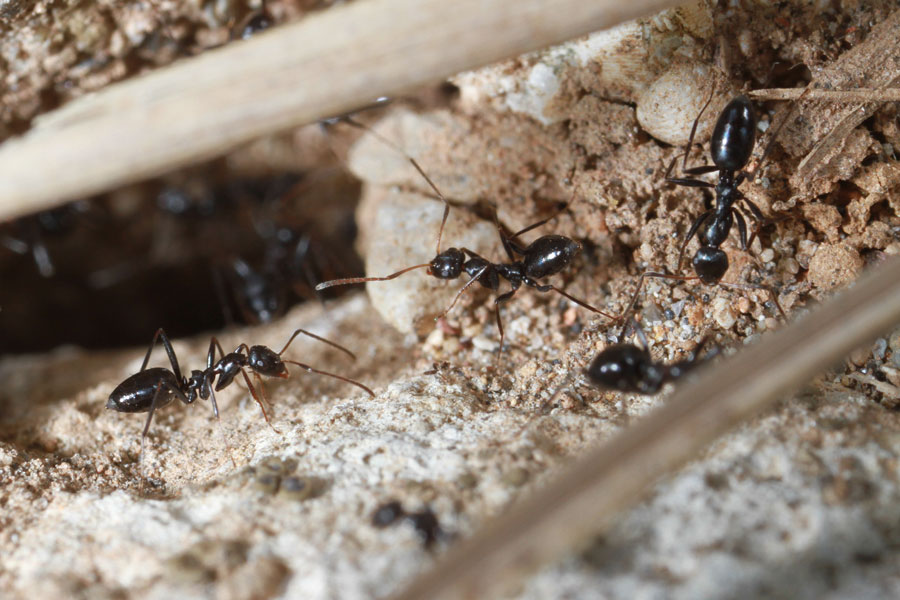Alien Ants Research Project

Ants are not only one of the most familiar animals to us in nature, but they also dwarf other organisms in terms of their density and degree of sociality. They play a wide variety of roles in various environments as predators, prey, pollinators, dispersers for plants, and soil improvers. Every region is home to a delicate balance of ants and the ecosystems they inhabit, which have developed over the course of a long history. If this balance is disturbed by alien species introduced through human activities, it may significantly alter this ecological balance and could adversely affect our lives as well.
The OKEON Churamori Project conducts research on the monitoring and control of invasive alien ants, such as fire ants, tropical fire ants, Argentine ants, and browsing ants, which present potential threats to Okinawa’s ecosystem and society. This research is funded by the Okinawa Institute of Science and Technology (OIST) and subsidized by the Okinawa Prefectural Government’s Nature Conservation Division and funds from the Ministry of the Environment.
Research on monitoring and control techniques for fire ants (Solenopsis invicta) and tropical fire ants (Solenopsis geminata)
Fortunately, no fire ants have been found in Okinawa as of September 2020. However, in light of an increasing number of suspected cases of fire ants found in ports on mainland Japan (Honshu) and the spread of fire ants in northern Taiwan, the danger of fire ants invading Okinawa Prefecture is imminent. In preparation for that eventuality, we are conducting research under the OKEON Churamori Project on the development and implementation of monitoring techniques for early detection, the creation of a system for early control, and the dissemination and sharing of information with the people of Okinawa.
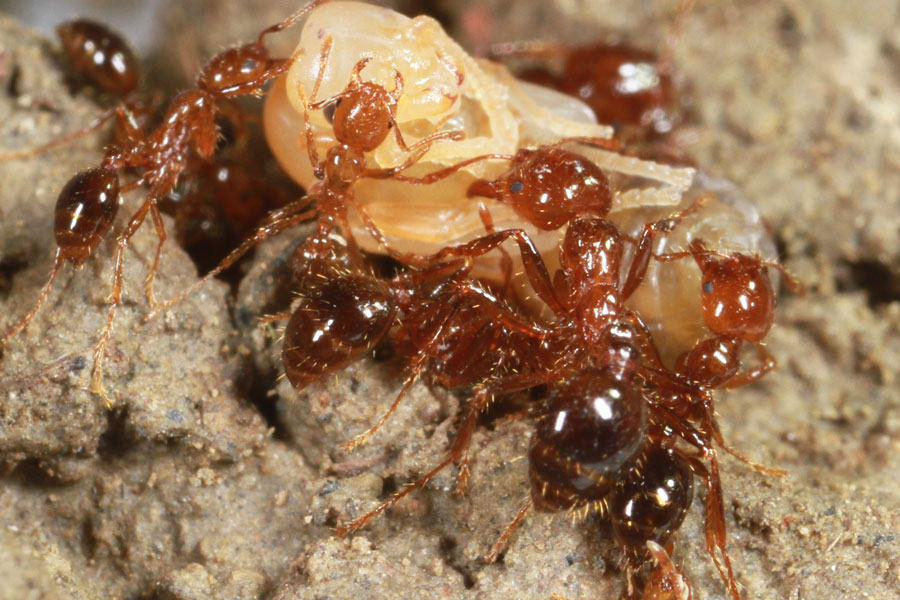
1. Development of identification techniques and research methods for early fire ant detection
The early detection of fire ants necessitates information such as how to distinguish fire ants from other ants found in Okinawa and what fire ants like to eat, as well as techniques such as an efficient research method for fire ant detection. The OKEON Churamori Project has been focusing on developing and validating such basic techniques in cooperation with the Okinawa Prefectural Government, the Ministry of the Environment, and other related organizations.
How to distinguish fire ants from other ant species found in Okinawa
Since many ant species commonly found in Okinawa are not found in Honshu, and vice versa, identification methods developed in Honshu do not always work for identifying fire ants in Okinawa. Therefore, it is necessary to identify the differences between fire ants and Okinawa’s local ant species. Immediately following the discovery of fire ants at ports in Honshu, our project researched fire ant identification and created informative materials. Those materials include a flyer we made in cooperation with the Okinawa Amami Nature Conservation Office and the Okinawa Prefectural Government to warn people in Okinawa about fire ants.
- “Fire ants!? Read this first!!” flyer [PDF 1.6 MB]
http://kyushu.env.go.jp/naha/Fireant.pdf
(Created by the Okinawa Amami Nature Conservation Office, Okinawa Prefectural Government’s Nature Conservation Division, Okinawa Institute of Science and Technology Graduate University (OIST), and OKEON Churamori Project)
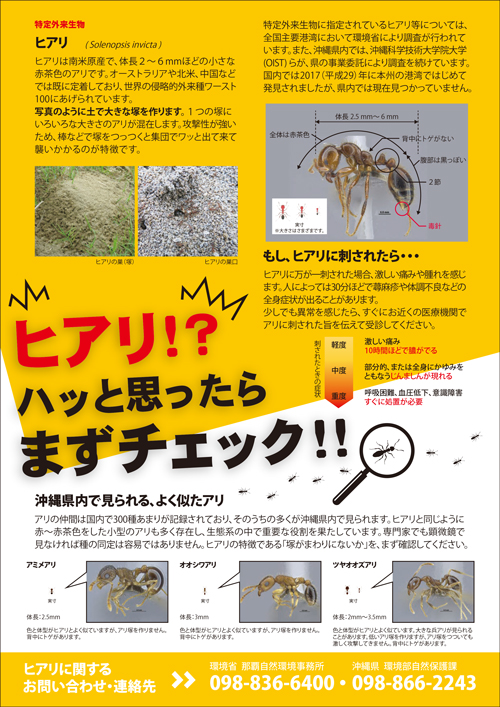
What do fire ants like to eat?
Baiting is often used to monitor small ants crawling on the ground in order to determine if their numbers are increasing or decreasing. For this, it is important to know the kinds of foods preferred by the ants under study. For fire ants, the more attractive the bait is, the more reliable the study will be. Thus, our team traveled to close-by northern Taiwan, where fire ants are prevalent, and with the help of researchers from National Taiwan University, conducted field experiments to determine fire ant food preferences. The findings of this study have been incorporated into the fire ant surveillance currently underway in Okinawa Prefecture. We also created a handbook that outlines techniques for attracting fire ants, which has been included in the publicly available Okinawa Prefecture Fire Ant Control Manual.
- Okinawa Prefecture Fire Ant Control Manual
Appendix 1: Bait Trap Research Method (PDF: 610 KB)
https://www.pref.okinawa.jp/site/kankyo/shizen/hogo/documents/shiryou1.pdf
(Website of the Nature Conservation Division of Okinawa Prefecture’s Department of Environmental Affairs)
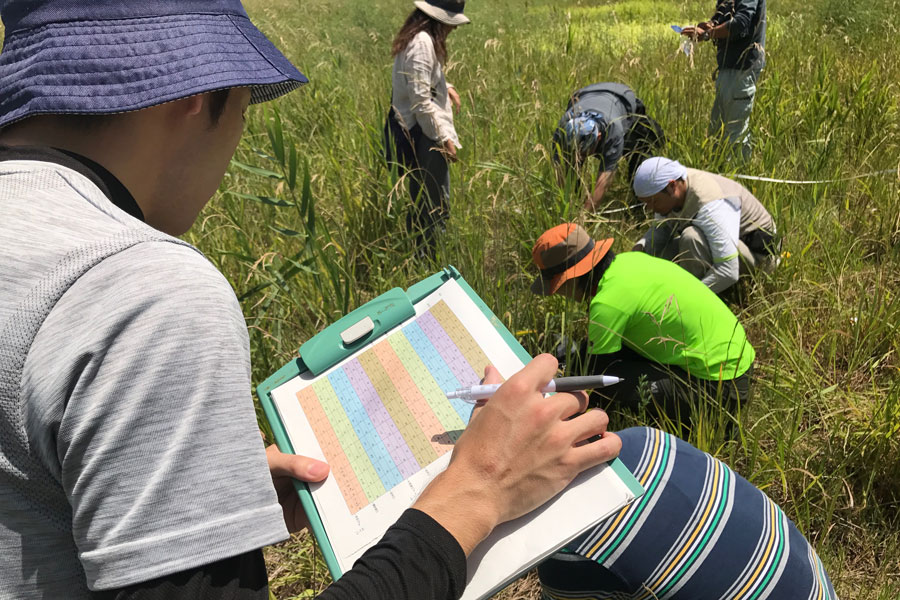
What is an effective research method?
In order to monitor invasive alien ants, it is important to effectively combine multiple research methods. These include techniques for attracting fire ants using their preferred baits, using traps for winged ants (SLAM traps), and employing time unit sampling (TUS) to collect as many ants as possible in the field work area. Which techniques are used depends on the ant species to be monitored and the particular stage of invasion. Our project examined the characteristics of each research method, as well as which combination of methods would work best in different situations given our research results on fire ants in Okinawa and Taiwan. These results have been published in Okinawa Prefecture’s Invasive Ant Countermeasure Project report and made available to the public.
- FY 2019 Invasive Ant Countermeasure Project Report
Chapter 2. Establishing Monitoring Techniques/Systems for Fire Ants, etc. (Part 3) [PDF: 3,534 KB]
https://www.pref.okinawa.jp/site/kankyo/shizen/hogo/documents/h31hiari-2-3.pdf
(Website of the Nature Conservation Division of Okinawa Prefecture’s Department of Environmental Affairs)
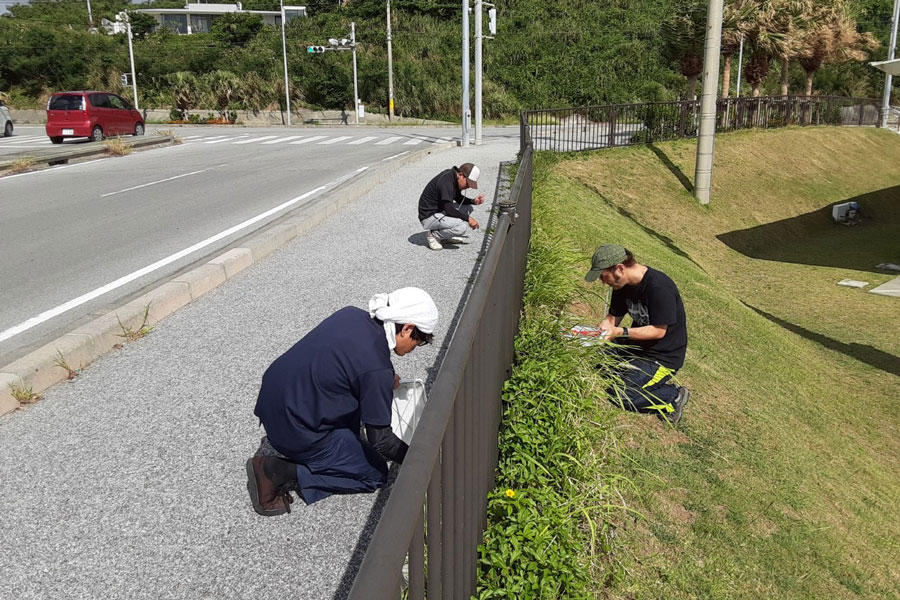
2. Building a system for early fire ant detection and sharing information with local communities
No single research institution or project alone can handle the monitoring of fire ants or controlling them at the time of detection. Such implementation requires collaboration with the government, research institutions, and local communities. The OKEON Churamori Project is contributing to a system to protect Okinawa from fire ant infestation by building a cross-governmental cooperative framework, developing training programs for government employees and business operators, creating lecture programs for citizens, and more.
The knowledge gained through these activities is applied towards the control and monitoring of fire ants, but also browsing ants which were first detected in Okinawa in 2020.
Building a cross-governmental cooperative framework
In the event that fire ants are found in Okinawa, it is crucial to have cooperative frameworks in place with the government that determine which agencies are responsible for responding. For example, container yards, which are often mentioned in national news covering fire ant detection, are strictly controlled and usually inaccessible to researchers or government agencies without jurisdiction over them. This is why building a cooperative framework with government agencies and operators that manage container yards is the first step in fire ant monitoring and control. Viewing the potential problem of invasive fire ants through the collective lens of ant experts, our project team identifies and proposes countermeasures while helping researchers develop such cooperative frameworks. Working with the Okinawa Prefecture Environmental Science Center, we published potential damage estimates from invasive fire ants in Okinawa to provide the government with the data necessary to take adequate control measures.
- Potential Economic Impact of the Red Imported Fire Ant Solenopsis invicta in Okinawa
Yukiko Aoyama, Masashi Yoshimura, Masako Ogasawara, Mayuko Suwabe, and Evan P. Economo
Japanese Journal of Ecology 70: 3-14 (2020)
https://www.jstage.jst.go.jp/article/seitai/70/1/70_3/_article/-char/ja/
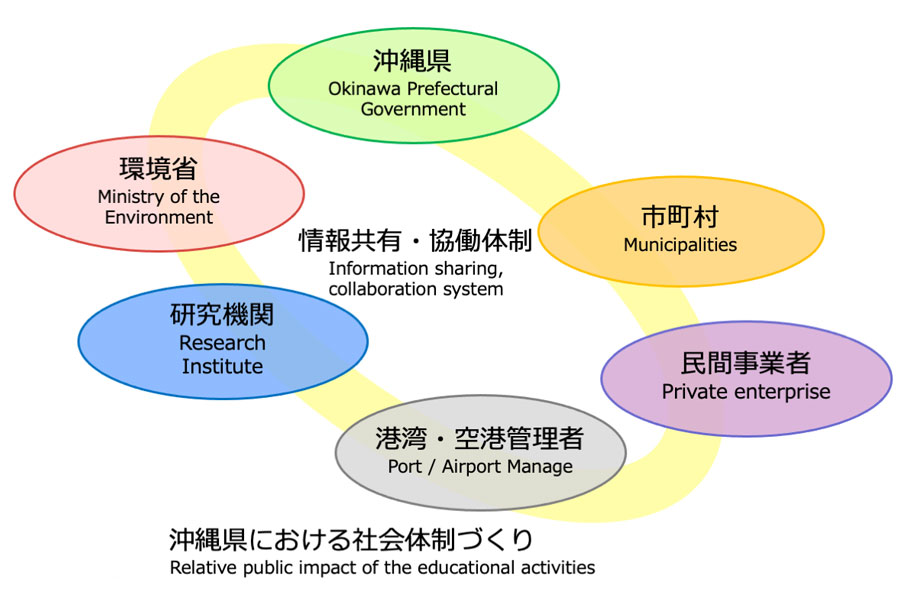
To learn best practices about fire ant eradication, our team also traveled to New Zealand, where invasive fire ants were successfully eradicated. There we were educated about their advanced initiatives, from detection to eradication, as well as the administrative system they used to engage the public in tackling the invasive species problem. We are very keen on applying these lessons to developing a similar system in Okinawa, and have summarized this in a report.
- FY 2019 Invasive Ant Countermeasure Project Report
Chapter 3. Establishing Control Techniques/Systems for Fire Ants, etc. [PDF: 3,082 KB]
https://www.pref.okinawa.jp/site/kankyo/shizen/hogo/documents/h31hiari-3.pdf
(Website of the Nature Conservation Division of Okinawa Prefecture’s Department of Environmental Affairs)

Developing training programs for government officials and business operator
In Okinawa Prefecture, different government agencies have been training their staff for the possible discovery of fire ants. These staff include front-line public health center personnel, municipal government officials, and port and logistics operators. Our project develops and offers a fire ant identification training program run by experts that covers the current status of fire ants, potential damage they could inflict, and easy ways to distinguish fire ants from other ant species found in Okinawa.
- Workshop for port operators
https://groups.oist.jp/ja/oerss/post/2020/06/04/oerss012
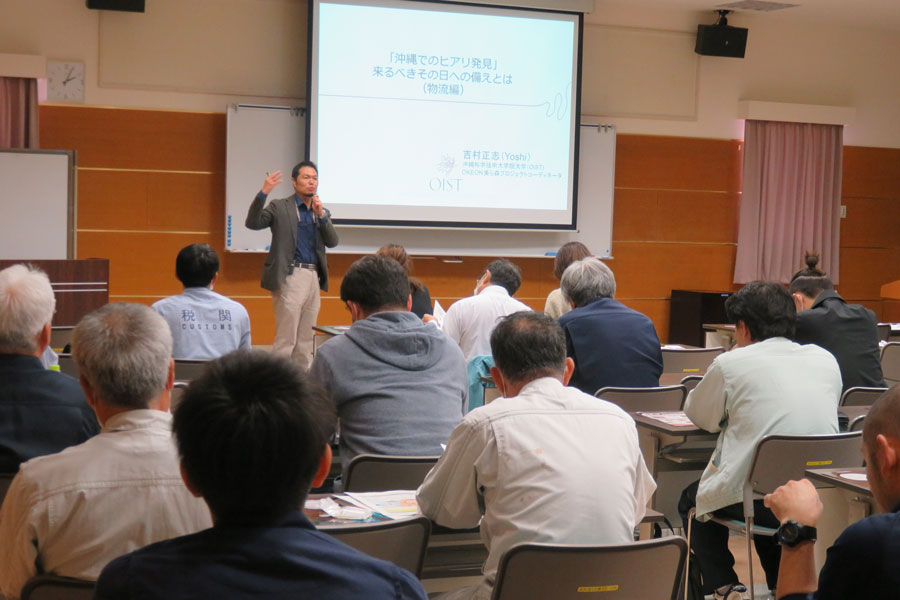
Developing lecture programs for citizens
Developing lecture programs for citizens
Regarding fire ant monitoring, there exist limitations to the extent that government and research institutions can enact monitoring due to budgetary and human resource restrictions. However, fire ants and other alien species will remain a problem for many years to come. Cooperation of the public is necessary in order to conduct long-term, extensive monitoring, which is vital to early detection and response. The OKEON Churamori Project develops and implements fun programs that disseminate expert knowledge about invasive species, including how to identify fire ants. This initiative is part of our joint research collaboration with Hokkaido University’s CoSTEP program and Obihiro University of Agriculture and Veterinary Medicine on information communication and dissemination techniques, which are essential to combatting invasive species.
We have thus far developed and implemented the following two programs:
- Species identification event for elementary school students: “Let’s Become an Ant Expert Today!” https://groups.oist.jp/ja/oerss/post/2020/05/26/oerss011
- Science workshop for adults (high school age and up): “A Diversity of Creatures Beneath Your Feet and Invasive Species: Can You Distinguish Fire Ants from Other Ants?”
Designed for specific targets and purposes, these programs were found to be effective.
We also conduct joint research with high schools in Okinawa using the TUS ant survey package, indirectly contributing to create a talent pool of local ant experts.

Research on eradication and monitoring techniques for browsing ants (Lepisiota frauenfeldi)
Browsing ants (Lepisiota frauenfeldi), which were first detected on Honshu in the Port of Nagoya in 2017, and have since been found in Tokyo, Osaka, Fukuoka, Kagoshima, and Hyogo prefectures, were found on Okinawa-jima Island during a survey conducted by the Ministry of the Environment in 2020. Browsing ants have quickly expanded their range worldwide due to global trade, and their impact on ecosystems has been reported around the world. It is vital that they be eradicated in Okinawa before they spread and cause damage to local ecosystems. However, information about browsing ants is still sparse, and we must develop both eradication and monitoring techniques necessary for effective control.
The OKEON Churamori Project is leveraging our knowledge about fire ant control and working with the Ministry of the Environment and other related government agencies to develop a cooperative framework for browsing ants. In addition, we are collaborating closely with the Okinawa Amami Nature Conservation Office to control and monitor browsing ants along a 2 km stretch of national road, in parallel with technological development. For this invasive species prevention project, which is informed by the latest research, we are also partnering with the Entomology Laboratory of the University of the Ryukyus, the Environmental Conservation Division of the Naha City Department of Environment, and a private company. The data obtained through this study should help improve browsing ant eradication techniques.
- Okinawa Starts Eradicating Nests of Ecosystem-Destroying Invasive Ants
https://www.okinawatimes.co.jp/articles/-/620115
Okinawa Times Plus, August 22, 2020
